Belgium’s Historic Treasures: Your 4-Day Travel Guide
- wanderer
- Aug 6
- 14 min read
Updated: Aug 25

As a travel enthusiast I always wanted to explore Europe. Over the years we made many plans to visit places like Ireland, Scotland, Rome, Italy, Greece to name a few.
Unfortunately none of those plans panned out as planned.
But this year I got an unexpected offer to visit Belgium for work in February. And even though it was going to be cold and freezing there, i grabbed the opportunity with both hands, as they say :)
I got 2 whole weekends to explore Belgium and, being the adventurous (some may call over-enthusiastic) person that I am, I made the most of every moment. And did I mention this was my first solo trip!
Here is my 4 day Itinerary for exploring the best of Antwerp, Bruges and Ghent. As always, 4 days are by no means adequate to explore these places but it will give you a good taste of quintessential European history with a splash of a vibrant city in the mix.
Short on time? Click on this printable itinerary for a quick summary of all the highlights!
Day 1:
Antwerp was my base of operation for this itinerary.
I flew from San Fransisco to Amsterdam. There is no direct flight to Antwerp, you can either fly to Brussels or Amsterdam and take a train from there to Antwerp. I picked Amsterdam, as I had been there before (stay tuned for another post on that!), so was a bit more comfortable with finding my way around. The Amsterdam Central train station and the Amsterdam International Airport are in the same building making life easier.
I reached Amsterdam in the morning and took an afternoon train to Antwerp central station. We will keep coming back to this station throughout our trip but its worth mentioning that the Antwerp Central train station is itself a stunning piece of architecture and history.
There are many hotels conveniently located within walking distance of the station. I picked YAYS Antwerp Opera by Numa, situated 10 mins from the Antwerp Central station and in the middle of downtown. Also these are serviced apartments so they come with a fully equipped kitchen and washer dryer in unit. There is a supermarket right next to the apartments, which made my life simpler since I am a vegetarian and didn't have to spend time hunting for food options every evening. As I mentioned earlier, I was there for 10+ days so a service apartment made more sense for me than a hotel in terms of price and amenities. I would also suggest to book these if you are going with family/kids, as it makes logistics much easier.
We will keep day 1 low key, we need to be well rested for our way more ambitious 4 days. Take a stroll along the main downtown street in the evening, its bustling with people and lined with shops from all around the world and grab a fresh, warm waffle with a drizzle or 2 of chocolate sauce.
Day 2: Antwerp
We begin our day with a substantial breakfast as we have plenty of walking ahead of us.
Let's kick off our journey by returning to the Antwerp train station to capture some Instagram-worthy photos. On the way, you'll notice (if you didn't already yesterday, possibly due to jetlag) the numerous diamond stores. Indeed, we are in the world's oldest diamond capital.

Pro tip!
The stores are enticing, but purchase diamonds only if you're knowledgeable about jewelry and can distinguish between real, lab-grown, or even basic crystals! I can't, so I had to avoid them. However, it's not all bad news, as most stores offer certified diamonds, which I assume would be a safer choice.
Belgium is home to several chocolate museums, and our research highlighted two in particular: Choco Story in Brugge and Chocolate Nation in Antwerp. We opted to visit the world's largest Belgian chocolate museum, Chocolate Nation, conveniently located just a five-minute walk from the train station.
After visiting, I can confidently say that Chocolate Nation is a must-see. It offers more than just exhibits—it's an engaging, interactive journey that traces the cocoa bean's path to delectable chocolate tasting. You'll discover fascinating themed rooms, enjoy an engaging audio tour, and have the opportunity to taste ten different types of chocolate, including the distinctive ruby chocolate that Belgium helped develop. Whether you're a chocolate enthusiast or simply curious, this place promises a delightful, unforgettable experience you won't want to miss!
Next stop for today is the Cathedral of Our Lady. You can either walk 20mins from chocolate nation, taking in all the shops and alleys on the way or opt to take a 3min metro train ride from outside the chocolate museum.
If you visit just one place in Antwerp, let it be the Cathedral of Our Lady. Standing in the square, looking up at its soaring spire, I was genuinely struck by how much more impressive it is in person than in any photo. Inside, the scale and beauty are instantly captivating—the vaulted ceilings, sunlight through centuries-old stained glass, and a sense of calm that’s hard to describe.
What really stood out for me were the Rubens paintings, displayed right where they belong, adding to the cathedral’s unique atmosphere. We will be covering some more cathedrals on this trip, but this one stands apart for how art, architecture, and history come together so naturally. It’s a peaceful and inspiring stop in the heart of Antwerp, and well worth your time.

After taking in the beauty of the Cathedral of Our Lady, lets wander just a few steps over to the Grote Markt, Antwerp’s lively main square. The atmosphere there is instantly welcoming, surrounded by rows of ornate guild houses and the grand City Hall.
At the center of the square, Brabo’s Monument really stands out. The statue tells a quirky local legend: a giant named Druon Antigoon once terrorized the city, demanding tolls from those crossing the river and cutting off the hands of anyone who refused. The hero Brabo finally defeated the giant, cut off his hand, and threw it into the river—an act that supposedly inspired Antwerp’s name (“hand werpen” means “to throw a hand” in Dutch).
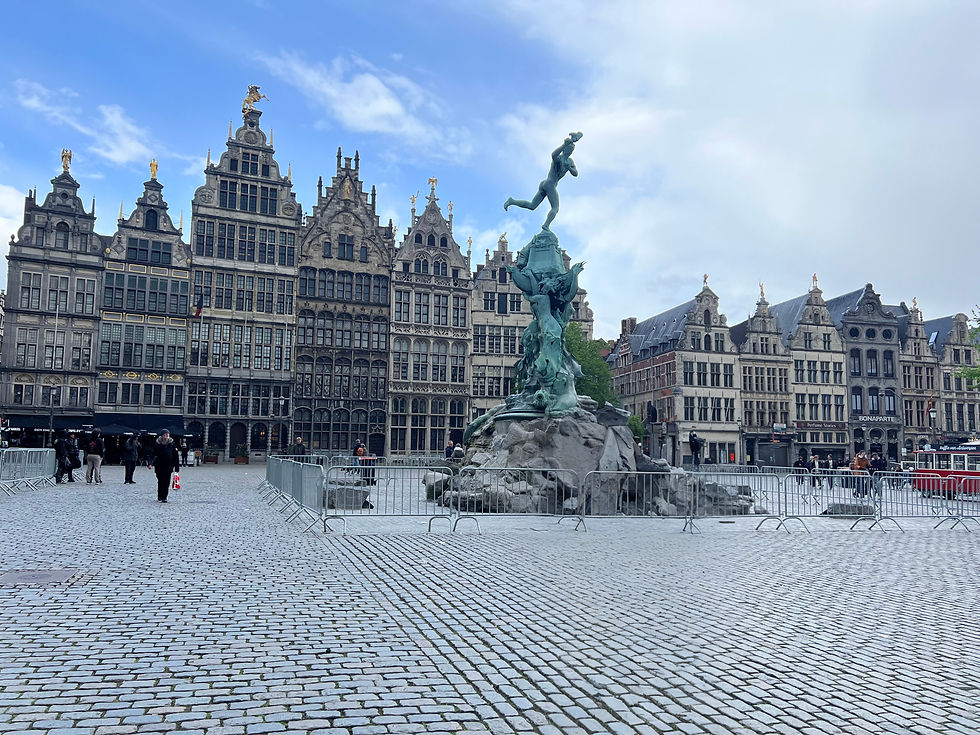
Pause here for a moment, taking in the details of the fountain. The square is a great spot to relax, grab a coffee or lunch or like we did treat yourself to a waffle from House of Waffles, just steps from the square. This cozy spot is known for serving up both classic Brussels and Liège waffles, freshly made and topped just the way you like them. Whether you go for something sweet with fruit and chocolate or try a savory twist, it’s the perfect way to pause and enjoy a true Belgian treat while taking in views of the historic center. The warm, welcoming vibe makes it an ideal spot to relax and refuel before continuing your Antwerp adventure.
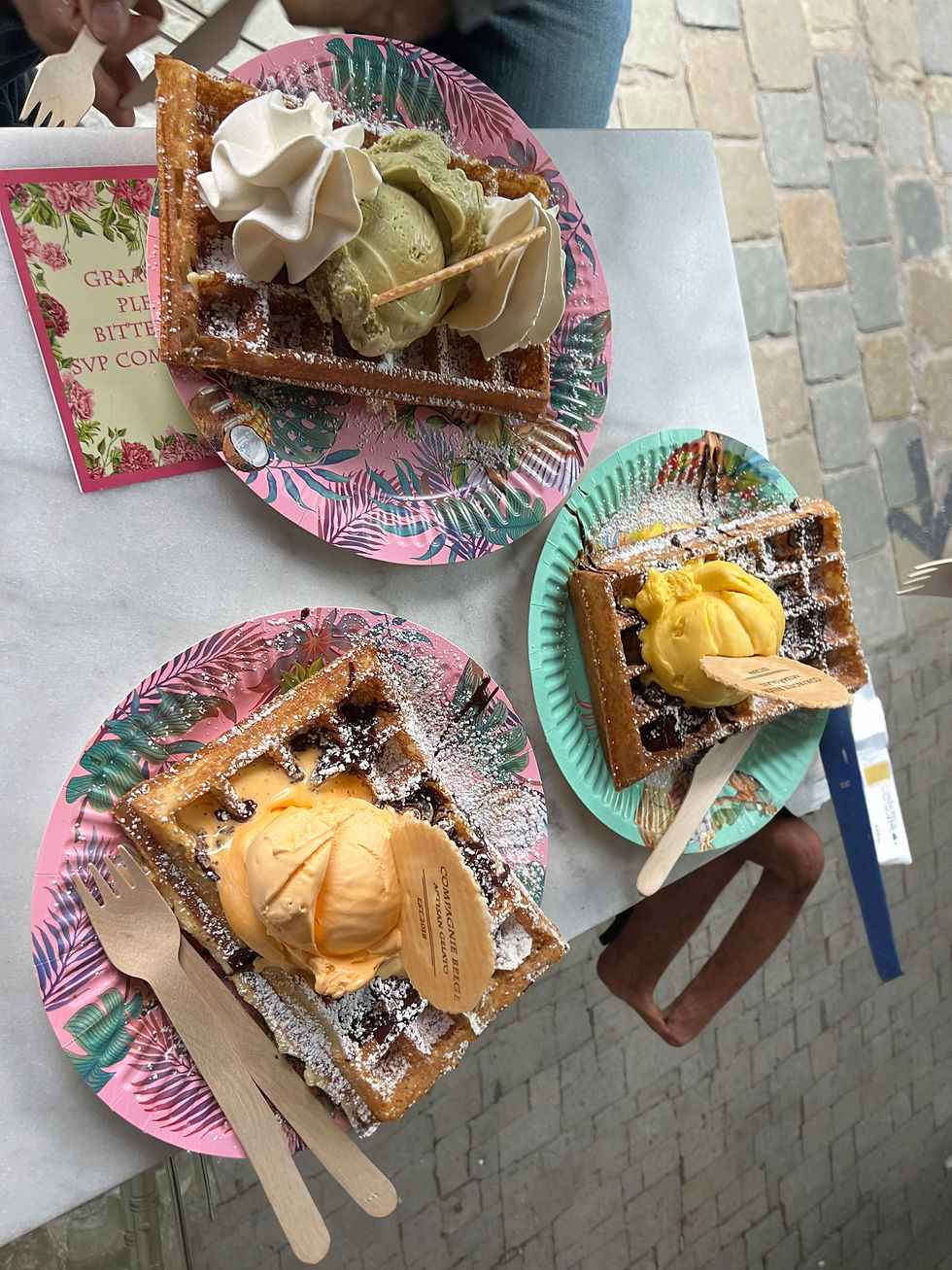
After enjoying a waffle, make your way over to Antwerp City Hall, which anchors the Grote Markt with its striking façade. Even if you’ve seen other historic buildings, this one stands out for its unique blend of Flemish and Italian Renaissance styles—a real innovation in its day. The ornate façade is covered in statues, coats of arms, and intricate carvings, all designed to show off Antwerp’s wealth and importance during the city’s golden age.
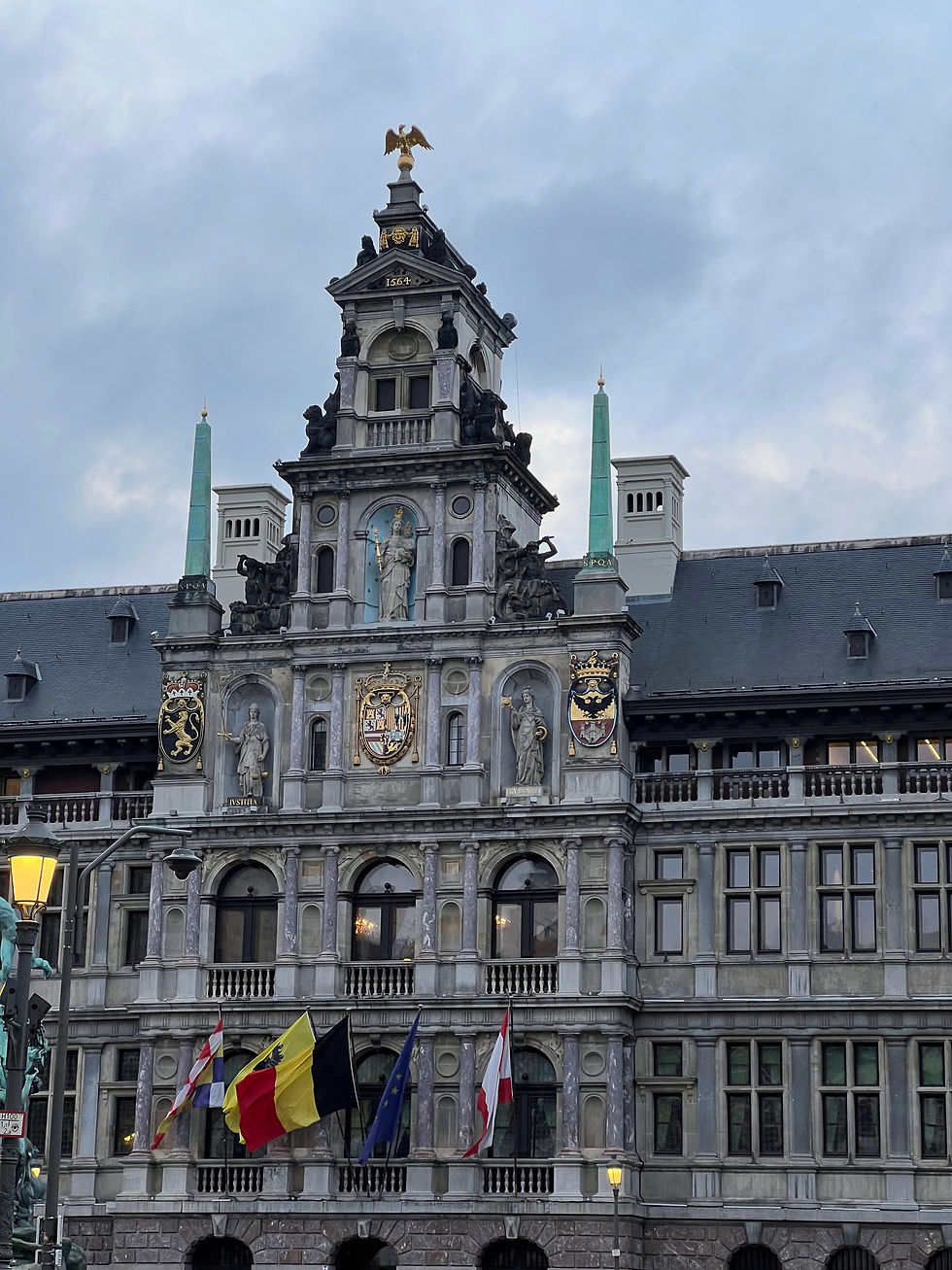
It is fascinating how the building mixes classical architectural elements—like Doric and Ionic columns—with local Flemish details, creating a look that’s both grand and distinctly Antwerp. Even if you don’t go inside, it’s worth visiting just to soak up the atmosphere and snap a few photos. If you get the chance to join a tour, you’ll get to see some of the grand interiors and learn even more about the city’s fascinating past.
We did not plan for the tour, but if you have the time check out the tour timings and book in advance here:
The final destination for today before dinner is the magnificent Het Steen.
As the day winds down in Antwerp, we make our way to Het Steen for an atmospheric evening stop. This striking medieval fortress—Antwerp’s oldest building—sits right on the banks of the Scheldt River, just a short stroll from the city center. Originally built in the early 13th century to defend the city and control river access, Het Steen has served as everything from a fortress and prison to a residence and museum.

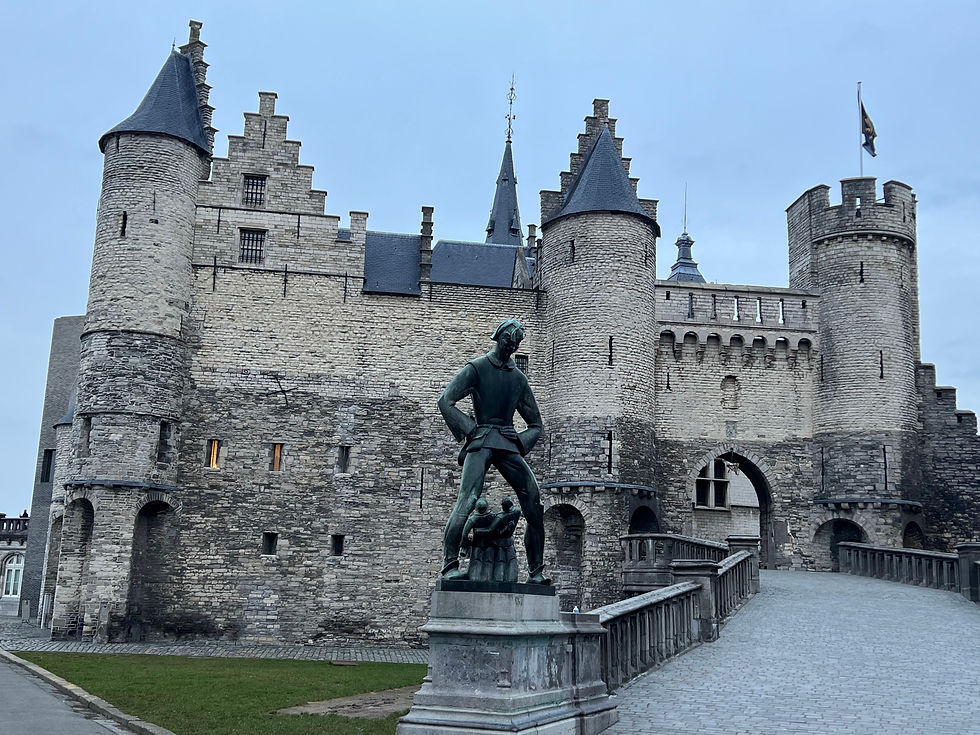
What makes Het Steen so special is how its centuries-old stone walls, turrets, and fairy-tale details blend with modern renovations, creating a space that feels both historic and inviting. The recent restoration has turned it into a vibrant visitor center, complete with exhibitions and panoramic views over the river—especially beautiful as the sun sets.
In the evening, the castle’s silhouette against the glowing sky is truly magical. It’s the perfect spot to soak up Antwerp’s medieval charm, snap some memorable photos, and reflect on the city’s long and fascinating history before heading out for dinner or a riverside stroll.
Some places we tried for breakfast/lunch and dinner:
Day 3: Bruges
Train is the most convenient way to travel in Belgium. Book your tickets at:
Weekends tickets are half off. Also when you book through them, you don't have to book a timed ticket. The tickets are date based and can be used on any train on that day.
As this was my first solo trip I decided to take a free walking tour through Guru tours. The tour itself is free but they appreciate tips.
Just be aware that when on this tour, you will not be able to go inside any of the places. So pick a tour time such that you have enough time after the tour to visit the individual places. I picked the historical tour of Brugge.
Whether you take the tour or decide to explore on your own, we start with Brugge Market square, which is a short walk from the train station.


The Markt is the vibrant centerpiece of the city and an ideal place to kick off your Brugge experience. Framed by charming, colorful facades and dominated by the impressive Belfry, the square is always buzzing with activity—horse-drawn carriages, lively market stalls, and the hum of people enjoying the scene from bustling cafés.
While the cafés lining the square offer unbeatable views (albeit at tourist prices), I found that exploring the nearby side streets reveals cozy, local spots with just as much character. Whether you decide to sit and people-watch, snap photos of the iconic stepped gables, or climb the Belfry for panoramic city views, the Markt perfectly captures the spirit and storybook beauty of Brugge. It’s a must-visit, and the energy here will instantly make you feel part of the city.
Next visit, The Belfry of Bruges is hard to miss, rising above the Market Square with its striking medieval architecture. Climb the 366 steps for an incredible view over the city’s rooftops and canals—a real highlight if you enjoy a bit of adventure. Along the way, you’ll pass the old treasury and get a sense of the tower’s rich history. It’s a memorable way to see Brugge from a whole new perspective.


To the dismay of my walking tour guide, I felt fortunate to be in Bruges during a Venetian parade in the Market Square. It was delightful to see everyone dressed in Venetian costumes. However, I do understand how it can be frustrating for locals and guides, as these parades cause unnecessary delays with the crowds.
Next we have 2 options, Church of Our Lady and the Basilica of the Holy Blood.
If you are drawn to art, architecture, and history, I’d recommend the Church of Our Lady. Its soaring brick spire is one of the tallest in the world, and inside you’ll find Michelangelo’s famous ‘Madonna and Child’ sculpture—one of the few Michelangelo works outside Italy. The church is also home to the impressive tombs of Mary of Burgundy and Charles the Bold, beautiful stained glass, and a blend of Gothic styles that reflect centuries of Bruges history.


If you are fascinated by religious relics and unique spiritual traditions, the Basilica of the Holy Blood is truly special. Tucked into Burg Square, this basilica houses a revered relic said to contain a cloth stained with the blood of Christ, brought to Brugge after the Second Crusade. The basilica’s two levels—one Romanesque, one Gothic—offer a distinct atmosphere, and the daily display of the relic is a moving experience for many visitors. The church’s rich history and annual Procession of the Holy Blood make it a significant spiritual and cultural site.
Personal Recommendation:
If you have time, visit both—they’re close to each other and offer very different experiences. But if you must choose, I’d lean toward the Church of Our Lady for its world-class art and architectural beauty, unless the story and tradition of the Holy Blood relic especially intrigue you.
After exploring the Church of Our Lady and admiring its art and architecture, take a short stroll to Boniface Bridge (Bonifaciusbrug), just behind the church. The walk leads you through picturesque gardens and past historic buildings, bringing you to one of Bruges most charming and photogenic spots. Nestled near the Gruuthuse Palace, the bridge offers beautiful canal views and a peaceful atmosphere—perfect for a quick pause and some memorable photos before continuing your journey.
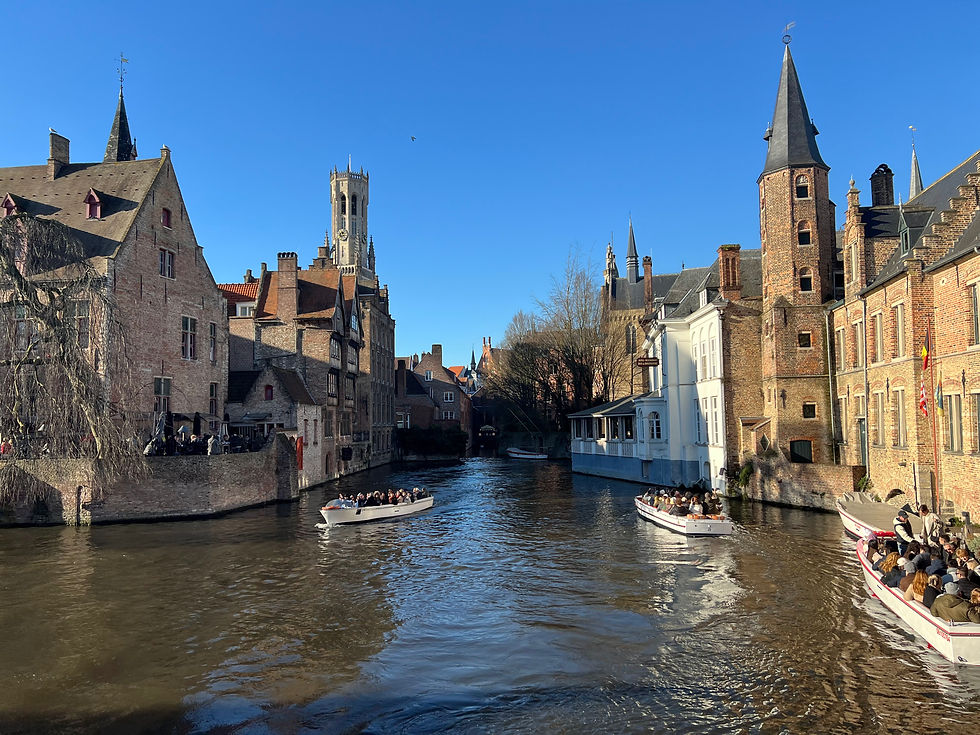
Boniface Bridge may be one of the city’s newer bridges, but it feels timeless, with its stone arches and storybook views of canals, overhanging medieval houses, and leafy courtyards. It’s an especially charming spot to pause, snap a few photos, and enjoy the romantic atmosphere that makes Brugge so memorable.
Next stroll to peaceful, The Béguinage de Bruges (Princely Beguinage Ten Wijngaarde). It is a UNESCO-listed retreat just minutes from the city center. Founded in 1245, it once housed beguines—pious women living in a close-knit community. Today, you’ll find whitewashed houses, tranquil gardens, and a quiet church, all set around a serene, tree-lined courtyard. It’s a lovely spot for a reflective stroll and a glimpse into Bruges unique spiritual history—just remember to respect the calm atmosphere as you explore.
After enjoying the tranquility of the Béguinage, make your way to Huisbrouwerij De Halve Maan, Bruges historic family-run brewery. Before heading inside, pause in front of the brewery to share a fun bit of local history: this is where the people of Bruges earned their nickname, the “Fools of Bruges.” Legend has it that when Emperor Maximilian visited the city, the townspeople asked him for permission to build a madhouse. He supposedly replied, “Just close the city gates—you already have enough fools inside!” The nickname stuck ever since.
While you’re here, take a look at the section of beer pipeline on display, which actually carries beer beneath the city streets—a quirky modern touch to Brugge’s brewing tradition. Then step inside for a brewery tour or a taste of their famous Brugse Zot.
After your visit to Huisbrouwerij De Halve Maan, a canal boat tour is the perfect way to wind down your afternoon before dinner. Head to one of the nearby boat landing stages—several are just a short walk from the brewery.
The tour will take you along Bruges scenic canals, including lovely views of the Minnewater, or “Lake of Love.” As you glide past medieval facades, charming bridges, and willow-draped banks, you’ll see the city from a whole new angle. It’s a relaxing and romantic way to soak in Bruges atmosphere and catch some beautiful photos as the evening light sets in.
After your canal tour, you’ll find yourself perfectly placed to enjoy dinner in Bruges. There are plenty of great options just a short walk away—whether you’re in the mood for a classic Belgian bistro, cozy Italian, or something more contemporary. Take your time wandering the illuminated streets, and let the relaxed pace and magical evening light make your meal even more memorable.

I intended to return to my hotel before it got too late, but I missed the train I had planned to take. The Belgian train website is incredibly useful for finding trains throughout the day, and if you're running late and can't walk to the train station, the bus schedule on Google Maps is a lifesaver. I managed to catch the next train and still made it back on time.
Be sure to review the train schedule ahead of time and organize your evening plans accordingly.
Day 4: Ghent
The next day, I headed back to the train station, feeling excited and ready for my next adventure: Ghent, famous for the incredible Ghent Altarpiece.
To kick off my visit, I decided to start with the farthest spot on my list—Gravensteen Castle, also known as the Castle of Counts. From the train station, I caught a bus that took me straight to the castle, making it an easy and convenient first stop in the city.


Whether you’re drawn to the intrigue of medieval justice, the grandeur of historic architecture, or simply want to soak in sweeping views of Ghent, Gravensteen Castle delivers a rich, immersive experience. It stands proudly as a symbol of the city’s medieval heritage and offers a deep dive into the past that’s both educational and captivating. Its imposing stone walls, engaging exhibits, and panoramic views from the keep vividly showcase the power and daily realities of the Counts of Flanders.
For me, it was more than just a visit—it was a journey through time that left a lasting impression and a deeper appreciation for Ghent’s history and culture. If you find yourself in this charming Belgian city, don’t miss the chance to explore Gravensteen Castle. It’s a highlight that truly brings the medieval world to life.
Pro tips:
Wear comfortable shoes for navigating narrow, spiral staircases.
Allocate 1.5 to 2 hours to fully explore the castle and its exhibits.
Use an audio guide or join a tour to enrich your experience.
Bring a camera for stunning photos of the architecture and city views.
Note that the castle is not wheelchair accessible due to its historic structure.
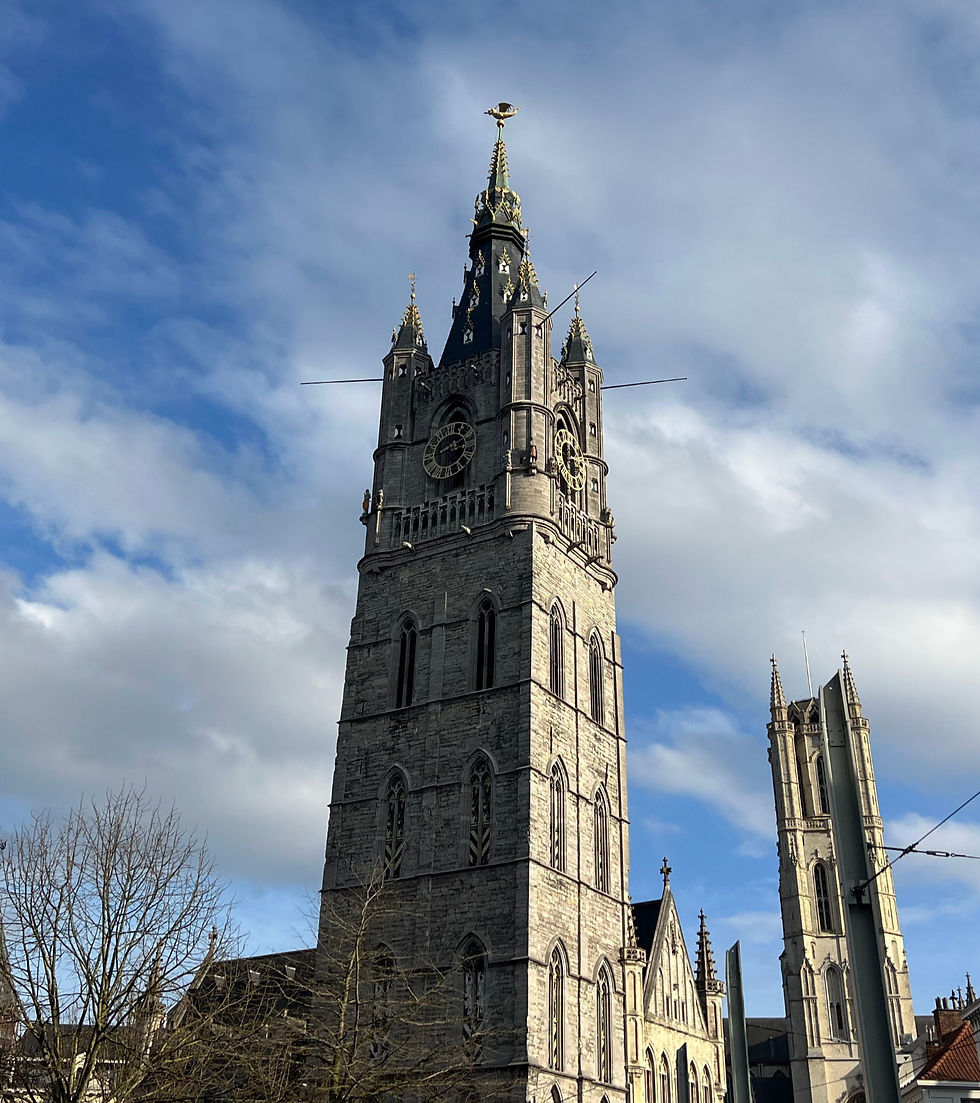
Next, I followed the river and began my walk towards some of Ghent's most enchanting locations: Groentenmarkt, St. Nicholas Church, St. Bavo’s Cathedral, Graffitistraat, Saint Michael’s Bridge, and Saint Michael’s Church. I eventually spent some time beneath Saint Michael’s Bridge. Here’s a closer examination of ea
ch site.
Groentenmarkt is a lively historic square in the heart of Ghent, known for its vibrant market atmosphere and rich history. Originally a site for livestock and later fish markets, today it buzzes with local produce stalls, artisanal goods, and weekend markets. The square is framed by stunning medieval and Renaissance architecture, including the Groot Vleeshuis, a historic meat hall dating back to 1251. Interestingly, it was historically a place of public executions, marked by the “Sire van Maldegem” column nearby.
Continuing my walk, I arrived at one of Ghent's oldest and most significant landmarks, St. Nicholas Church, it is a stunning example of Scheldt Gothic architecture, built mainly from blue-gray Tournai stone. Its large central tower once served as an observation post and bell tower before the Belfry was built. The interior features a Baroque high altar and rich decorations post-1566 iconoclasm. The church is open to visitors and requires no tickets.

Situated on Sint-Baafsplein, just a brief stroll from St. Nicholas Church, St. Bavo’s Cathedral stands as Ghent’s impressive Gothic cathedral. It houses the renowned Ghent Altarpiece (Adoration of the Mystic Lamb) created by the Van Eyck brothers. The cathedral's origins trace back to a 10th-century church, with significant Gothic enhancements occurring between the 14th and 16th centuries.
Note that though entrance to the cathedral is free; a ticket is required to see the Ghent Altarpiece in the visitor center.

I almost walked past this marvelous little alley, located between Hoogpoort and Onderstraat! This narrow alleyway is Ghent’s official graffiti street, a vibrant and ever-changing open-air gallery. Once a red-light district, it transformed in the 1990s into a legal space for street artists, showcasing colorful murals and urban art.
The street is a living archive of Ghent’s urban art scene.


A stunning stone arch bridge completed in the early 20th century, Saint Michael’s Bridge offers some of the best panoramic views of Ghent’s iconic skyline, including the “three towers” of St. Nicholas Church, Belfry, and St. Bavo’s Cathedral.
It is a perfect spot for photography and romantic strolls.


Up ahead from the bridge is the Saint Michael’s Church, this late Gothic Roman Catholic church dates back to the 12th century, with construction continuing into the 16th century. It features a mix of Gothic and Baroque styles, with a rich interior and an unfinished tower capped with a flat roof.
The church is open to visitors interested in architecture and history.
With some time to spare before returning to the hotel, I chose to relax beneath Saint Michael's Bridge.
The area beneath Saint Michael’s Bridge offers a delightful spot to pause and take in the views of the river Leie and the historic buildings nearby. It’s a serene place to contemplate Ghent’s rich history and enjoy the picturesque surroundings.
This riverside walk combines history, art, architecture, and local culture, providing numerous opportunities to savor Ghent’s culinary offerings and vibrant street life.
For dining near Groentenmarkt or Saint Michael’s Bridge, you'll find many excellent restaurants and cafés serving Belgian and international dishes, ideal for a leisurely meal or a quick coffee break after sightseeing.
This area of Ghent truly embodies the city’s essence—historic yet lively, artistic yet inviting. It’s a walk that beautifully merges the city’s past and present.
Day 5:
As my journey comes to an end, I’m left with a deep sense of gratitude and wonder. Exploring Belgium—its winding streets, incredible history, and mouthwatering food—exceeded every expectation I’d carried for European travel. What began as an unexpected work trip turned into a solo adventure full of discovery, reflection, and unforgettable moments from Antwerp to Ghent. I hope this itinerary inspires you to seek your own adventures, embrace spontaneity, and find joy in every new experience. Until the next trip—au revoir!
Looking for a quick-reference list? Here’s a printable itinerary for your Belgium adventure:










